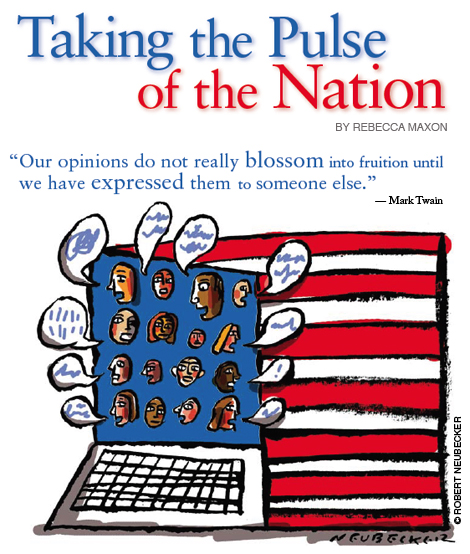

The pollsters and pundits are at it again. With the 2007 election almost upon us and the 2008 presidential primaries just around the corner, it seems one can’t open a newspaper or turn on the television or radio without hearing about a poll. From “American Idol” predictions to polls about the presidential candidates, people are fascinated with numbers.
A month after George Bush’s re-election, surveys were being conducted
on … a theoretical presidential election between Hillary Rodham Clinton and Rudy
Giuliani.For instance, “The day after one election, we are into the next,” says Peter Woolley, professor of political science and executive director of the PublicMind™, FDU’s independent polling institute. “In fact, the 2008 presidential election is well underway, even though there has yet to be a single primary vote.” As early as December 2004, only a month after President George Bush’s re-election, surveys were being conducted on who would win a theoretical presidential election between Democrat Hillary Rodham Clinton, New York’s senator, and Republican Rudy Giuliani, former mayor of New York City.
“The reason we follow [polls] is that we are fundamentally curious about what other people think. It’s a kind of social activity,” says Woolley. Election polling was first promoted by the Literary Digest— which predicted the 1916 election of Woodrow Wilson as president — and scientifically refined by George Gallup, who began polling in 1936.
Now, polling is conducted in democracies throughout the world and has become a part of Western culture. “People are always interested in who is projected to win an election,” says Robert Mrozinski, BA’04 (M), the PublicMind’s project director at TMR Inc., an independent polling firm and PublicMind’s field partner.
Elections are akin to a horserace (even Las Vegas runs odds on the outcomes), and people enjoy watching the showdown on election night. One interesting contest was the 2006 New Jersey Senate race between Republican Tom Kean, Jr., son of the popular former governor, and Democrat Robert Menendez, the appointed incumbent. Many predicted it would come down to the wire, and many voters were anxious to see if a minority candidate would be elected as New Jersey’s senator for the first time in history. Menendez actually won the race with a comfortable lead of eight percentage points. A week before, PublicMind had predicted a nine- to 10-point margin for Menendez, contrary to the majority of polls, which forecast a much closer race.
“What I find personally interesting, Mrozinski says, “is that people seem to care more about the numbers and who is ahead than they do about the issues surrounding the elections.”
| Nonprofit and grass-roots organizations frequently use polls to get their issues into the public eye and even onto the campaign agenda. |
|---|
From Big Business to Grass Roots

Joseph Calvanelli, Jr., MBA’86 (T), founder and president of TMR, notes, “More and more organizations are conducting research and publishing the results to enhance their organization’s public relations efforts. You can’t pick up a daily newspaper or news magazine without seeing some sort of reference to a poll.”
Political polling goes far beyond election predictions. “In a representative democratic society,” says Woolley, “we rely on the notion that public opinion will in some way drive public policy.” Public-opinion polling serves as an important measure of what the public thinks between elections.
People want their voices heard. Policy-related opinion research has been done on topics ranging from such controversial issues as same-sex marriage and civil unions to smoking bans and cellphone use in automobiles. Those who have formed opinions on an issue are apt to respond when a telephone researcher calls.
“Polls are a way of facilitating the link between public opinion and public policy,” says Woolley. How else would office holders be able to represent the public’s interest? “They need to satisfy not only the people who voted them into office, but also those who are likely to vote next time they are up for election.”
Nonprofit and grass-roots organizations frequently use polls to get their issues into the public eye and even onto the campaign agenda. For instance, a 2005 PublicMind press release for the New Jersey Farm Bureau attracted readers with the social aspects of the survey: eight out of 10 New Jerseyans shopped at roadside farm stands or farmers’ markets and seven of 10 knew that the Garden State got its name from its farming industry. The press release then drew attention to the issues of farmland preservation and the use of eminent domain laws to seize farmlands for development, such as to build a new school or recreation area.
“It is one thing to like the idea of farming and buy New Jersey produce at roadside stands and grocery stores,” John Schiemann, former chair of the social sciences and history department at the College at Florham, professor of political science and, until recently, director of research for PublicMind, said. “But it is an entirely different thing to make yourself aware of and form opinions about complex environmental legislation affecting farmers.”
The bureau’s follow-up survey in 2006 showed that 90 percent of New Jersey voters had heard of the issue of eminent domain and nearly three-quarters disapproved of using it to take active farmland “to build a new school or ball field.” Picked up by the Associated Press (AP), the news coverage blanketed the region, appearing in news media from Washington, D.C., to New York City.
FDU Magazine Home | Table of Contents | FDU Home | Alumni Home | Comments
©Copyright 2007 Fairleigh Dickinson University. All rights reserved.
For a print copy of FDU Magazine, featuring this and other stories, contact Rebecca Maxon, editor, 201-692-7024 or maxon@fdu.edu.